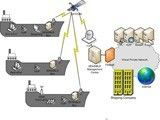
-
StatusCompleted
-
Status date2014-12-09
The objective of the project is to implement a resource management system that performs bandwidth allocation at administrative domain level independent from the satellite network Network Control Centre (NCC).
SENSIBLE’s target is to supply the SATCOM market with a service capable to distribute dynamically the satellite bandwidth and manage the quality of service for a set of users within the same administrative domain, to which a fixed amount of bandwidth is assigned from the satellite operator. SENSIBILE will be able to detect the user’s needs (in term of bandwidth for the activated services) and shape the traffic between the terminals of the same administrative domain.
The service will provide three types of bandwidth utilisation with respect to the QoS:
- Guaranteed bandwidth (constant over time),
- Guaranteed bandwidth session based (variable with the number of active sessions for a particular unit),
- Unguaranteed bandwidth.
The following figure shows the scenario for the maritime segment.
Since the project start, the key issues that we were addressed are:
- State of the art that has confirmed the relevance of our proposal,
- The user requirement definition, with the deep analysis of the operational scenarios of GNV and other ship-owners. This analysis has produced the increase of the operational scenarios and URs, confirming the validity of the proposed architecture,
- The definition of the different options for the management protocol. This study aims to allow the simulation as soon as possible, the results of which we will support in choosing the Management Protocol,
- System requirements definition to cover the User requirements,
- Business Plan.
ITS is currently present in the market of satellite services through a close collaboration with several satellite service providers (such as Eutelsat/Skylogic, CapRock and MTN). In addition, the company is present in the maritime market through its subsidiary SIRM, a company strongly focused on this market and specialises in providing solutions and value added services through VSAT broadband connectivity.
The product and service that will be marketed at the end of the project improves performance of satellite access to the internet, with a significant reduction in costs for professional ships and pleasure boats.
The components of the system are:
- SENSIBLE Box, which is a dedicated box that performs traffic shaping at third OSI level. The SENSIBLE box can be equipped with various communication interfaces for all connectivity needs. In addition to routing and traffic shaping this equipment also offers:
- An integrated I-PEP
- A NMEA interface
- The possibility to manage interfaces like VSAT, GPRS, HSPA, INMARSAT, WI-MAX and to perform roaming according to the connection availability and the bandwidth profile defined by the Sensible Administrator.
- SENSIBLE Service Center, which is a centralised system placed at the satellite Hub, or in an external data centre linked through a VPN, used for the bandwidth management. The system collects all the bandwidth requests sent by the individual SENSIBLE Boxes and, depending on the amount of bandwidth and QoS user profile, configures the SENSIBLE Box traffic shaping which has to be adopted. The SENSIBLE Service Center is able to show an overview of the current status of occupied bandwidth of the individual units along with their position on a GIS map. The SENSIBLE Service Center is also equipped with a VoIP call control that allows users of each unit to communicate with each other.
- The SENSIBLE Management Centre could also be equipped with a centralized I-PEP based on a new congestion control algorithm, named TCP-Noordwijk. The SENSIBLE I-PEP could be deployed in stand-alone respect the other system features.
The following approach will be performed:
Problem study and analysis:
- Analysis of the user’s needs
- State of the art analysis
- Study of the problems raised and solutions envisaged
Service appliance development:
- Service architecture definition
- Service simulation
- SENSIBLE Box development
- SENSIBLE Service Center system development
Service appliance validation and verification:
- Service Validation by means emulator
- Service integration
Service testing on field and dissemination:
- Dynamic bandwidth Management centre setting-up
- Ships equipment for test on field
- On field testing
- Service dissemination
Service deployment
The project started on the 22nd March 2010, the duration is 20 months.
Simulations performed with the Network Simulator 2 validated the concept and demonstrated the capabilities of this approach, with a responsive adjustment of the Sensible boxes to the upload rate configured by the Sensible Control Centre. At the same time the positive impact of the system has been demonstrated by simulations in presence of a large number of Sensible boxes and an unbalanced bandwidth allocation. Tests performed with real hardware and simulated or real satellite links confirmed the matching of internal classification of flows according to the configured priority, which was extensively tested and proved working correctly as expected.






